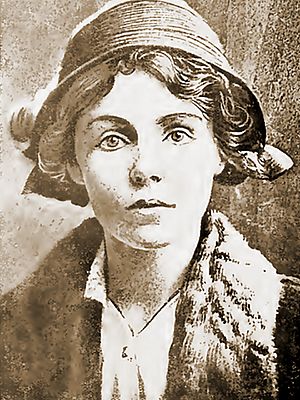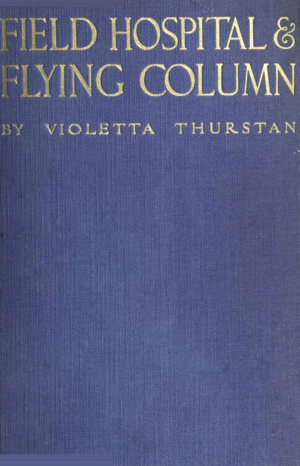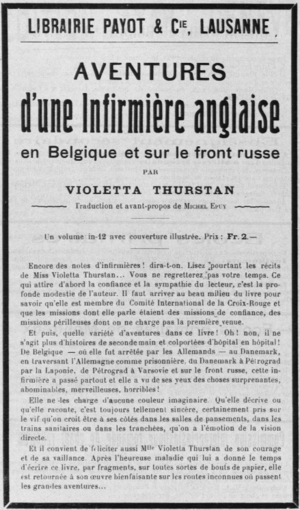Violetta Thurstan facts for kids
Quick facts for kids
Violetta Thurstan
|
|
|---|---|

Violetta Thurstan before 1917
|
|
| Born |
Anna Violet Thurstan
4 February 1879 Ore, Sussex, England
|
| Died | 13 April 1978 (aged 99) Penryn, Cornwall, England
|
| Nationality | English |
| Occupation | Nurse Author |
Violetta Thurstan (born February 4, 1879 – died April 13, 1978) was a brave English nurse, a talented weaver, and an organizer who helped many people. She spoke several languages and traveled all over the world. Violetta wrote many books, especially about her adventures as a nurse during World War I. She received special awards from three different countries for her courage, including the Military Medal.
Contents
Violetta's Early Life
Anna Violet Thurstan was born on February 4, 1879, in Ore, Sussex, England. She was the oldest of four children. Her father, Edward Paget Thurstan, was a doctor.
Her family moved often, so young Violetta went to different boarding schools. These included a German Catholic school and the Ladies' College, Guernsey.
Violetta started her nursing training in 1897 in the UK. She trained at the London Hospital in Whitechapel. From 1905 to 1914, she worked as a nurse at the Bristol Royal Infirmary. During this time, she also learned many languages. She studied history and geography too. She earned a special degree in modern languages and fine art from the University of St Andrews.
Nursing in World War I
Violetta Thurstan joined the British Red Cross in 1913. When World War I began in August 1914, she was sent to a hospital in Charleroi, Belgium. She led a group of nurses there.
Soon, the German army took over the area. They ordered all British nurses to leave. Violetta was forced to travel to Copenhagen with armed guards. From there, she traveled through Sweden and Finland to reach Russia.
In Russia, she joined a mobile medical unit called a "flying column." This unit was led by Prince and Princess Peter Volkonsky. Violetta helped wounded soldiers in places like Łódź and Warsaw. She was injured by shrapnel and also became very sick with a lung illness called pleurisy.
Writing About Her Experiences
While she was recovering, Violetta wrote her first book. It was called Field Hospital and Flying Column. The book described her experiences from the past few months. It was very popular and was even translated into French.
When she returned to England to recover, Violetta gave talks about her adventures. In her book, she explained why well-trained nurses were so important. She also pushed for nurses to be officially registered. For several years, she helped organize the National Union of Trained Nurses (NUTN).
Helping Refugees and Soldiers
By the end of 1915, Violetta was back in Russia. She represented the NUTN and helped refugees on the Eastern Front. She wrote another book, The People who Run, about the millions of people who had to leave their homes.
In late 1916, she became the head nurse (matron) at a hospital in De Panne, Belgium. This hospital was very close to the front lines. Soon after, she moved even closer to the fighting. She managed a dressing station in Koksijde. This was a place where wounded soldiers received first aid.
Violetta bravely helped evacuate wounded soldiers from Koksijde while under fire. For her courage, she received the Military Medal. She also received awards from Russia, Belgium, and Serbia. These included the Russian Cross of St George and the Belgian Queen Elisabeth Medal.
Later War Service
After the evacuation, Violetta suffered from a delayed concussion. She needed more time to recover in the UK. In 1917, she published A text book of war nursing.
Her last job during the war was as matron at the Ostrovo field hospital in Macedonia. This was near the Salonika front. She became sick with malaria there. After recovering, she joined the Women's Royal Air Force as an administrator. She served until September 1919.
Years later, in 1978, she wrote another book about her war experiences. It was called The Hounds of War Unleashed.
Textiles and Helping Refugees in Africa
After her time in the Women's Royal Air Force, Violetta studied textile arts. She took courses in weaving and dyeing in Sweden, Italy, France, and Germany.
Around 1923, she became the Director of Bedouin Industries. This was in refugee camps in the Libyan desert. She worked under the British administration in Egypt. Here, she oversaw Bedouin women making beautiful carpets.
Violetta was in charge of buying supplies. On one trip to buy wool, she was the first European woman to spend the night in a Red Sea port. A newspaper even reported that no other European woman had traveled as far into the desert as she had. She traveled a lot in the region and across Europe when she went home. During this time, she was a member of the Royal Geographical Society.
She wrote articles about dyes for the Egyptian Horticultural Review. In 1930, she published Use of Vegetable Dyes for Beginners. This book was very popular and is still respected today. She also wrote A Short History of Decorative Textiles and Tapestries (1934) and Weaving Patterns of Yesterday & Today. In 1956, she published Weaving Without Tears. A silk cot cover that Violetta designed and wove in 1935 is now in the Victoria and Albert Museum.
Spanish Civil War and World War II
In 1937, Violetta went to help during the Spanish Civil War. She worked with the Universities Ambulance Service. She helped get prisoners released in Almería.
When World War II started, she joined the Women's Royal Naval Service. She told them she was younger than she was! Her language skills were very useful in Naval Intelligence. She would board ships to search for illegal goods.
After the war, in 1945, she helped with the Catholic Relief Programme. She worked with people who had lost their homes and with prisoners of war. She helped in Italy, Egypt, and Austria. She also helped move and resettle children. She continued this work with the Allied Commission in Austria from 1946 to 1948. Pope Pius XII honored her for her work.
Later Life and Legacy
In her seventies, Violetta moved to Cornwall, England. She continued to weave, teach crafts, and write. She published two novels: Stormy Petrel in 1964 and The Foolish Virgin in 1966. The second book was inspired by her post-war aid work.
Violetta kept traveling. In 1958, she led a group of Cornish women on a trip to Rome. In 1966, she went to Greece as a crafts adviser. She stayed involved in textile arts in the UK. She attended a World Crafts Council meeting in London in 1967. She also advised on a dye garden at Probus Gardens in Truro in 1976.
In 1973, when she was 94 years old, she helped start the Cornwall Crafts Association. She was also made a Fellow of the Society of Designer Craftsmen. Violetta Thurstan passed away at her home in Penryn on April 13, 1978, at the age of 99.



